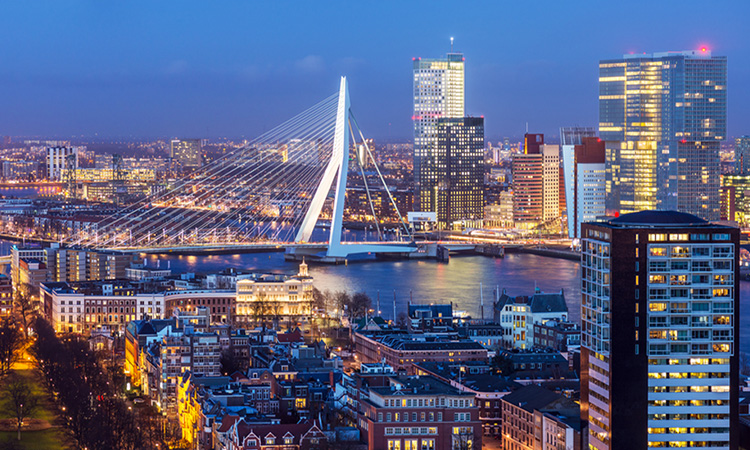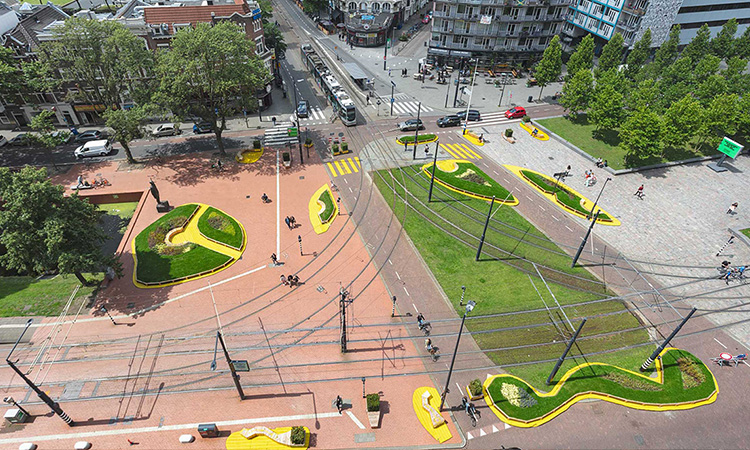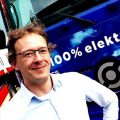Actively moving towards a greener and more climate-resilient Rotterdam
- Like
- Digg
- Del
- Tumblr
- VKontakte
- Buffer
- Love This
- Odnoklassniki
- Meneame
- Blogger
- Amazon
- Yahoo Mail
- Gmail
- AOL
- Newsvine
- HackerNews
- Evernote
- MySpace
- Mail.ru
- Viadeo
- Line
- Comments
- Yummly
- SMS
- Viber
- Telegram
- Subscribe
- Skype
- Facebook Messenger
- Kakao
- LiveJournal
- Yammer
- Edgar
- Fintel
- Mix
- Instapaper
- Copy Link
Posted: 15 December 2023 | Adrienne J. Acioly - City of Rotterdam, Arjan Oranje - City of Rotterdam | No comments yet
Adrienne Acioly, Project Manager – Mobility, and Arjan Oranje, Senior Programme Manager, from the City of Rotterdam sat down with Intelligent Transport’s Halimah Haque to discuss the city’s ambitious plans for sustainable mobility, active travel infrastructure and their role in achieving Rotterdam’s climate action targets.


Can you tell us about your experience working on sustainable and climate resilient infrastructure development in urban areas and how it aligns with the goals of the City of Rotterdam?
Arjan Oranje: Just weeks ago, our Board adopted the Climate Action Plan for the City of Rotterdam, which states that we have to reduce CO2 emissions by 25% by the end of 2026, and by 55% by 2030. Of course, by the end of 2050, along with the rest of the world, we have to be climate neutral. These goals are for the complete field of decarbonisation and sustainability across the Netherlands, including the built environment, our harbour for the city, renewable energies and, of course, the mobility sector.
Adrienne Acioly: We also have strategies which complement these goals that are related to active travel. For example, we are currently developing the Healthier and Safer Streets Programme, which includes improving safety throughout the City of Rotterdam. An increase in the number of cyclists and pedestrians in the area has prompted us to address road safety amidst the city’s growth and increasing traffic. The programme will see the speed limit reduced to 30km/h (20mph) in a large number of streets by 2025. We intend to fast track the 30km/h implementation in areas experiencing higher accident rates.
We also have a focus on low traffic neighbourhoods (LTNs). Part of this is the development of a new circulation plan for the city. The primary goal of this plan is to create safer and more liveable areas for our residents and workers. This can incentivise residents to make a more conscious decision about their modality, and also reduce the dependency on private vehicles. So, although these projects are perhaps not directly driven by decarbonisation, the shift that we hope they will achieve does contribute to reducing emissions.
When our city was re-built after World War II, it was done so in the – back then – most modern way: car-oriented”
Oranje: In our city, our residents have been asking for mobility change for the last decade by making different choices. When our city was re-built after World War II, it was done so in the – back then – most modern way: car-oriented. So, it’s really something that we now have traffic jams of bicycles in Rotterdam! We have seen an enormous growth in the use of bicycles, partly because of our policy, but mostly because residents are choosing to use the bicycle instead of the car. This behavioural change is one of the reasons why we are shifting the focus of our public space from the car towards active mobility.
Partly due to policy, partly due to climate change and air quality reasons, but mostly because residents are making different choices, we see this modal shift happen – and we want to facilitate those choices through infrastructure and a fair re‑distribution of the space.
Adrienne, as a project manager in mobility strategy and active travel infrastructure, what innovative solutions have you implemented to promote active travel and reduce car usage?
Acioly: As mentioned, we’re conducting the Healthier and Safer Streets Programme, which also includes the implementation of experimental traffic measure projects. The aim of these projects is to reduce traffic and to increase safety, particularly prioritising the streets where we’ve seen an increase in accidents, and to bring back the liveability of these areas.
These experiments trial tactical, low-cost measures, such as partial disclosures and traffic calming measures, and also physical improvements. They allow residents to experience, on a short-term basis, what it means to make these changes and experience the benefits. Due to a partial road closure, you may now have additional space to explore different modalities, such as incorporating more green elements or exploring other opportunities for space re-use. As the air quality improves, and noise pollution decreases, individuals can make more informed choices about their preferred mode of travel. These measures truly enable people to have that experience, to witness the benefits in action, hopefully encouraging a shift in modal behaviour. This is backed up with data. We collect quantitative and qualitative data to provide evidence and to understand the outcomes of these measures not only for us, but also for the residents.


Credit: Experiment oude westen gemeente rotterdam – bende (benderotterdam.nl)
What contribution do you think active travel has in achieving the City of Rotterdam’s climate action targets?
Having a more balanced shift to active travel allows for greater flexibility with the use of space and also keeps people healthier. We anticipate that the liveability will increase and the air will become cleaner”
Acioly: Choosing active travel obviously contributes to a nearly net zero polluting travel mode. This will help to improve the liveability of cities, enabling more green spaces, and diverse forms of public realm use, simply as these types of modalities require less space and produce no release of harmful emissions during travel. At the moment, as Arjan explained, Rotterdam is still quite a car-centric city. Despite progress, a significant amount of the space distribution is allocated to cars. So, having a more balanced shift to active travel allows for greater flexibility with the use of space and also keeps people healthier. We anticipate that the liveability will increase and the air will become cleaner.
Oranje: We are talking about sustainability, about energy transition, CO2, but there’s also a shortage of raw materials. Active travel, walking, cycling and public transport will make use of less raw materials than the car-orientated modality system. So, the more people that we can get on bikes or walking, of course it’s healthier, but our carbon footprint will also be reduced because of this choice.
How do you envision addressing congestion while maintaining a healthy, safe and pleasant environment for the city’s residents?
Acioly: The new circulation plan that is under development will help with this. The plan aims to optimise traffic efficiently, recognising that the complete removal of all cars on our roads is not feasible, nor desirable. The central question is, how to allocate space more effectively to accommodate other types of modalities alongside the existing car users? Right now, many modalities compete for limited space. So, where can you create low traffic neighbourhoods? And what are the key roads that car-users should travel on? This is where we’re currently striving to strike a balance and developing this plan. We’re trying to achieve a better balance between these diverse modalities and alleviate congestion for all travel modes. And then, hopefully, it will also stimulate a modal shift that empowers people to consider alternative transport choices, enhancing their travel options and allowing people to make informed choices.
Oranje: The key is that our residents, and also our political leaders, will experience the benefits of different choices.
How significant a role does engagement with stakeholders play in the successful implementation and long-term sustainability of the projects that you’ve mentioned, and what strategies would you employ to foster effective collaboration and maintain stakeholder support?
Acioly: I think we’ve both worked on stakeholder engagement in different ways. It’s a key strategy of the City of Rotterdam. With all of our projects, we engage quite actively with residents. We are committed to understanding the residents’ perspectives, including their concerns and desires, to inform policy decisions effectively and, likewise, integrating those policy decisions back into the community. For example, through the initiatives that I mentioned earlier, stakeholder engagement is very important for us to collect qualitative data. This allows us to get a better understanding of the effects and outcomes of the ideas and strategies that we have. I think key to this, as well, is that we are flexible enough to adapt to the needs and issues that may arise during the process.
Oranje: On decarbonisation of traffic, active mobility and electrification of fleets, we have some strategies working with the companies in our city. To give an example, we are introducing a zero-emission zone for freight by the start of 2025. It’s the largest zero-emission zone in the Netherlands, at 50km2. Of course, the effect here will be on the logistical businesses. Since 2014, we have been building a community of transport companies in our city, working together on the route to zero. This naturally includes zero pollution, but we have broadened the sustainable agenda to also include zero inefficiency and zero collisions and accidents.
It is this collaboration with businesses that has allowed us to learn that zero inefficiency is also a gaining point for businesses. Through co-operation with the businesses and the city government, we can learn to speak each other’s language and work towards the same goal together.
I can say that it’s rather a success, because we will have the largest zero-emission zone for logistics in the Netherlands. Not because we, as city officials, thought it was a good idea, but it was a question from the companies themselves. When businesses are asking for a larger zero-emission zone, I think we must all be doing a wonderful job together, because they want to make the transition.
Another benefit is that we are working together with the largest employers in our city. 40% of those working in our city are represented by them or working for them. In co-operation with each other, and with us, these businesses are making agreements and introducing measures to decarbonise their fleet, use electric cars and also make use of bicycles. When your employer is helping you to get to your work in an active way, it’s not only a choice for yourself, but one which is supported by your employer in making it possible.
How would you further enhance and expand the city cycling network, taking into account the diverse needs of different user groups and ensuring inclusivity?
Oranje: In the Netherlands, generally, the infrastructure is quite safe and well established for those who can cycle. However, we see some groups in the City of Rotterdam who have never learned to cycle, or are not confident with cycling, for whatever reason. We have set up programmes to help those people to cycle. There are projects giving bicycles for free to those who cannot afford them. There is help for those who do not have somewhere to park their bicycle at the home; we have special schemes to put their bicycles on the street in a safe way, without risk of it being stolen. There are also special programmes for schools, for people with different needs, to provide training on cycling safely, and also to help them to make use of other ways of transportation independently.
Looking to the future of mobility and sustainable infrastructure, what emerging trends or technologies do you believe will have the greatest impact on promoting active travel and reducing environmental impact in Rotterdam?
Oranje: I think that one technology that is bringing change, is already there. I’m speaking of the electric bicycle. We are already seeing a lot of car usage being replaced by electric bicycles, as they allow people to cover a greater distance than by a conventional bicycle. We can also see an increase in the use of bicycles by elderly people.




Related topics
Accessibility, Active travel, Air Quality, Infrastructure & Urban Planning, Passenger Experience, Public Transport, Sustainable Urban Transport
Issue
Issue 3 2023
Related modes
Bikes & Scooters
Related cities
Rotterdam
Related countries
The Netherlands
Related organisations
City of Rotterdam
Related people
Adrienne J. Acioly, Arjan Oranje







